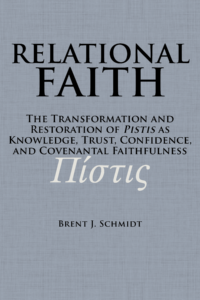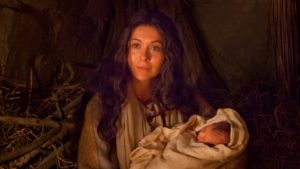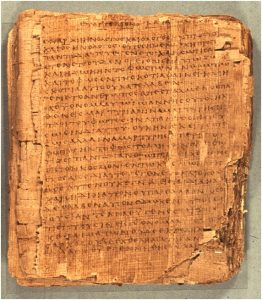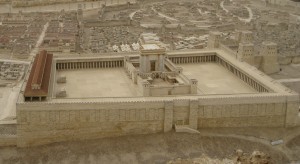by John W. Welch
As is well known from the often told Christmas story found in the Gospel of Luke, Mary wrapped her newborn son “in swaddling clothes” (Luke 2:7). What on earth were swaddling clothes, and why would Luke have bothered to include this detail in his account of the birth of Jesus?
While we may not know for sure exactly what kinds of clothes were used or how they may have looked in Jesus’ case, it seems highly likely that all infants in the ancient Mediterranean world were tightly wrapped in long bands of cloth. So these bands were not “clothes,” like a shirt or pants or pajamas, and they were not just a diaper, but long strips of cloth wrapped all around the baby.
Indeed, the early English translators of the New Testament probably used “clothes” as the plural of “cloth,” both here in Luke 2:7 and also in the passages describing the linen cloths used to wrap the body of Christ for his burial in Luke 24:12 and John 19:40; 20:5, 6, 7. In mentioning the burial cloths, the plural noun othonia (linen cloths) is used. But in Luke 2:7, no noun is used, but instead only a single Greek verb appears; translated by the King James translators as “wrapped in swaddling clothes,” esparganōsen is a past tense form of the word sparganoō, “to wrap.” The clear meaning of this word, in any text dealing with a baby, is to swath or bundle an infant.[1]
No indication is given here what was used to swaddle Jesus, but nothing in this particular word should be used “as a sign of poverty or of the Messiah’s lowly birth,”[2] since both rich and poor alike were swaddled. The Latin Vulgate rendered the Greek by saying that she wrapped him in “pannis,” meaning pieces of cloth or bandages, usually shabby rags. But because the Greek verb here clearly derives from the Greek noun sparganon (“band,” usually appearing in the plural and meaning specifically “bands for swathing infants” [3]), the Latin probably invites a possible misunderstanding. Luke’s statement does not imply a lack of ordinary preparation for the birth of Jesus. Aimed as it was to his Greek audience, Luke’s statement instead draws attention to “Mary’s maternal care; she did for Jesus what any ancient Palestinian mother would have done for a newborn babe.”[4]
Ancient Jewish and Greek sources, discussed below, indicate that wrapping an infant in this way was common, ordinary, and meaningful. On the night that Jesus was born, the angel told the shepherds that if they would go looking in Bethlehem, they would find “the babe wrapped in swaddling clothes, lying in a manger” (Luke 2:12). And they went quickly and indeed found the babe “lying in a manger” (Luke 2:16), but here the swaddling clothes are not mentioned. The angel had told the shepherds that something about this whole situation would be a “sign” (Luke 2:12). So, it is reasonable to ask, what is so significantly indicative here? It would probably not have been unusual to find a newborn baby in Bethlehem. And, it would not have been remarkable to find a baby wrapped in swaddling clothes. But to find a newborn in a manger, that would be very unusual and therefore singularly significant. After all, how many newborns are placed in a phatnē, most likely a feeding trough[5] for cattle, oxen, goats and sheep?
As far back as the time of Ezekiel in the sixth century B.C., swaddling was referred to as an indication that a baby was properly cared for. In Ezekiel 16:4, the Lord speaks to Israel about the abandoned and desperate condition in which He had found his people, saying “And as for thy nativity, in the day thou wast born thy navel was not cut, neither wast thou washed in water to supple thee, though wast not salted at all, nor swaddled at all.” In that allegorical description, the baby was cast out into an open field, unwanted and exposed, and the lack of salting (for drying and cleansing) and swaddling was a sure sign that the baby had been legally abandoned and could be claimed. This is evidence that swaddling was normal and significant well back into the ancient history and customs of Israel.
Swaddling bands are also used metaphorically of the creation of the earth in Job 38, speaking of the time in heaven when the morning stars and all the sons of God shouted for joy. As part of that creation, God reigned in the primordial sea, as if the earth had broken the waters within the womb as it was coming forth in birth (Job 38:8), and then God wrapped the earth overhead in the cloud or firmament between heaven and earth, when He “made the cloud the garment thereof, and thick darkness a swaddlingband for it” (Job 38:9). Here, God serves as a father, providing his creation with the kind of loving care and parental obligation that would have been commonly understood to be the first token of acceptance and validation given to a newborn by its lawful parents. Thus, when Mary wrapped Jesus in swaddling bands, this sends recognizable signals to all in their culture that this baby, who has come down as a creation of God, is wanted, owned, embraced, and is being fully cared for. Mary and Joseph were prepared at the time of the birth, having brought to the stall these bands in which to tightly bundle and gratefully receive the infant Jesus.
One writer has offered the following description of swaddling: “For years the Orientals of Bible lands have cared for an infant child much as it was done when Jesus was born. Instead of allowing the young baby the free use of its limbs, it is bound hand and foot by swaddling bands, and thus made into a helpless bundle like a mummy. At birth the child is washed and rubbed with salt, and then with its legs together, and its arms at its side, it is wound around tightly with linen or cotton bandages, 4-5 inches wide, and 5-6 yards long. The band is placed under the chin and over the forehead.”[6] Although based on customary practices whose antiquity cannot be determined precisely, nothing could signal more clearly the helpless state of a newborn human more than being wrapped tightly in any such way. Such a being has relinquished all power even to move, let alone to do, at that point, much of anything.

Nativity scene by Giotto di Bondone, Cappella Scrovegni a Padova
It is possible that swaddling bands were, at least on some occasions, marked in some way or accompanied by other tokens in order to identify whose baby it was. Babies could, after all, be easily mistaken, as can happen in hospitals even today. The importance of identifying features coming in connection with the swaddling bands of a child’s earliest infancy was understood widely enough that classical Greek and Roman tragedians and comic writers could make literary use of such bands and tokens as “objects left with an exposed child, the marks by which a person’s true birth and family are identified.”[7] Apparently, it was the combination of some sign, token, or marking with the concurrence of swaddling that was especially noteworthy. In the case of Oedipus, he was marked from his swaddled infancy (sparganōn) with a pin that riveted his feet together.[8] In the case of Jesus, the sign of being laid in a manger came together with his being swaddled.
But further evidence would need to be found to know if these bands or tokens were ever in some ways distinctive to particular families. It has been suggested that swaddling bands could be “embroidered with symbols indicating family history and genealogy,”[9] and indeed one may add that early Christian tradition associated Mary with spinning, so she may have had access to good cloth and thread out of which to make bands of swaddling cloth for her child. That being the case, since Joseph and Mary were from the tribe of Judah, the swaddling bands wrapped around Jesus “may have used symbols common to that lineage such as a lion, a lamb, or a tree of life,” together with the royal colors of blue and white,[10] but that idea, however endearing, goes well beyond anything we can say or know for sure.
Also, it may be that “according to ancient and modern custom, the embroidery, to be acceptable, must be exactly the same on both sides. This was a type showing that the outward life and the inner life were the same—they were never to have a ‘wrong side’ to their character,”[11] and that “under the wedding canopy, these decorated bands would be tied around the clasped right hands of the bride and groom; hence the saying, ‘they tied the knot.’ These bands would later be used to fasten the swaddling clothes of their children.”[12] Such a practice would nicely merge with the idea that swaddling conveyed the message that the child had not been abandoned but belonged under the marriage rights and privileges that blessed the home into which that child was received. But again, the authentication of these interesting suggestions, which are advanced on the basis of more recent practices, must await evidence from ancient sources.
So, what on earth were swaddling clothes, and what can be said of Luke’s inclusion of this detail in his infancy narrative? In the final analysis, they represent maternal care and concern, being wanted and owned, received and embraced, and when accompanied with some sign or token they could presage a portentous future. But most of all, these bands signal the helpless state of the newborn infant, within the bounds and conditions of earthly mortality. As the author of the apocryphal Wisdom of Solomon reflects, as he speaks in the voice of even the legendary king of Israel: “I myself also am a mortal man, like unto all. . . . When I was born I drew in the common air and fell upon the earth, . . . I was nursed in swaddling clothes (sparganois), . . . for there is no king that had any other beginning of birth. For all men have one entrance into life, and the like going out” (Wisdom 7:1-5). Thus, being wrapped in swaddling clothes, even as an eternal heir apparent, symbolizes—and perhaps does so more than any other accoutrement of life—one’s entrance into full humanity. Indeed, that the Lord Jehovah would become flesh as a helpless child and was swaddled like any other infant is an exquisite manifestation of his unfathomable condescension (see John 1:14; Philippians 2:7; 1 Nephi 11:16–20).
[1] Liddell, Scott, and Jones, A Greek-English Lexicon (Oxford: Clarendon, 1968), 1624.
[2] Joseph A. Fitzmyer, The Gospel According to Luke (I-IX) (Garden City, New York: Doubleday, 1981), 408.
[3] Liddell, Scott, and Jones, Greek-English Lexicon, 1624.
[4] Fitzmyer, Luke, 1624.
[5] Raymond E. Brown, The Birth of the Messiah (Garden City, New York: Doubleday, 1977), 399. Brown points out that the word phatnē can mean either “stall” or “manger,” but that “the picture of wrapping the baby and laying him down better suits a cradle-like manger.”
[6] Fred H. Wight, Manners and Customs of Bible Lands (Chicago: Moody, 1953), 108-9; quoted in Monte F. Shelley, Remembering Christ at Christmas (Orem: Summit View, 2008), 44.
[7] Liddell, Scott, and Jones, Greek-English Lexicon, 1624, citing Sophocles, Oedipus Tyrannus 1035; Menander, Perikeiromenē 15; Donatus ad Ter, Eun. 753, and possibly Aristophanes, Acharnenses, 431. In Plautus’s Rudens 4.4.111, the story alludes to a “custom of tying round the necks of children, when they were exposed, little tokens or ornaments, which might afterwards serve as means of recognition.” Richard Jebb, The Oedipus Tyrannus of Sophocles (Cambridge: Cambridge University Press, 1966), 110 n. 1035. Further examination of such references is called for.
[8]Oedipus Tyrannus lines 1034-35. He was exposed a few days after his birth, line 77, but thereby was recognized years later.
[9] Donna B. Nielsen, Beloved Bridegroom (Salt Lake City: Onyx, 1999), 35; quoted in Monte F. Shelley, Remembering Christ at Christmas (Orem, Utah: Summit View Publishing, 2008), 46.
[10] lds.org/pa/display/0,17884,7244-1,00.html.
[11] Nielsen, Beloved Bridegroom, 36; quoted in Shelley, Remembering Christ, 46.
[12] Nielsen, Beloved Bridegroom, 35-36; quoted in Shelley, Remembering Christ, 46.






